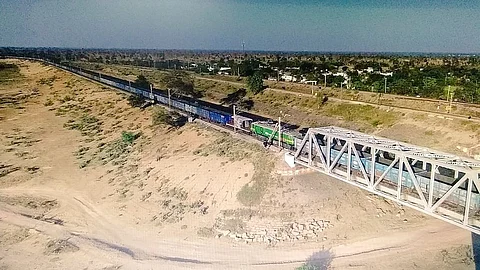

India’s railway history is as fascinating as it is old and surely no stranger to engineering milestones. The operation of Vasuki, however,—the country’s longest and heaviest freight train—marks a different kind of achievement. Measuring over 3.5 kilometres and comprising 295 wagons and six locomotives—a feature never before observed—this mega train isn’t built for speed or comfort, but for the sheer scale of freight movement that powers the nation’s economy. Here's a closer look at what makes Vasuki an extraordinary chapter in Indian railway operations.
It was on 22 January 2021 that Vasuki was operated by the South East Central Railway (SECR) zone between Bhilai (Raipur division) and Korba (Bilaspur division) in Chhattisgarh. The journey spanned a distance of about 224 kilometres and took approximately seven hours. The train was formed by combining five separate freight rakes into a single combination of integrated units making it the first such operational attempt of this scale in Indian Railways’ history.
At over 3.5 kilometres in length and weighing nearly 26,000 tonnes, Vasuki eclipses all previous Indian freight operations in scale. It carried approximately 27,000 tonnes of coal in a single haul—enough to fuel a 3,000 MW power plant for an entire day. By comparison, a standard freight train in India typically carries 58–60 wagons and transports roughly 3,800 tonnes of coal. Vasuki thus represented an immense leap in payload per journey.
Precision and muscle were needed to operate such a large equipment. A system of synchronised traction was used to disperse the six electric locomotives throughout the train. With this configuration, the lead driver was able to remotely operate every locomotive, ensuring that the train's traction and braking were consistent throughout. It decreased the chance of derailment, enhanced manoeuvrability on curves, and lessened pressure on couplings.
A locomotive pilot, an assistant loco pilot, and a guard were the only crew members in charge of Vasuki despite its enormous size. The emphasis on operational efficiency is shown by this staffing leanness. Over time, combining five rakes into one drastically lowers the number of runs needed and saves fuel and labour. The plan is in line with Indian Railways' overarching objective of boosting freight efficiency without requiring more infrastructure.
The Vasuki run is a component of Indian Railways' broader initiative to regularise long-haul goods trains, especially in industries like coal, which are still vital to the country's industrial and power sectors. With the continued demand for thermal coal, trains like Vasuki and its precursor SeshNaag offer a scalable model for effectively moving bulk goods. Additionally, shorter turnaround times and less traffic in crowded freight corridors are achieved by using fewer but larger trains.
"Vasuki" is a reference to Indian mythology. According to Samudra Manthan, Vasuki was the king of serpents that were employed as ropes in the ocean's churning. This freight giant slithering across central India is perfectly described by its moniker, which stands for endurance, strength, and coiled force.
Despite not being a passenger train, rail aficionados have taken to Vasuki. In Indian railways, it is uncommon to witness a train take almost four minutes to pass a station platform in its entirety. It provides a brief but memorable glimpse of industrial size in action for residents living close to important intersections like Bilaspur or Raipur.
Long-haul behemoths like Vasuki might proliferate as India updates its rail infrastructure and develops its designated freight lanes. Their capacity to transport enormous amounts of cargo in a single operation has the potential to improve supply chains, save energy expenses, and increase the sustainability of freight transportation. Vasuki is essentially a preview of how India will transport its commodities in the future.
